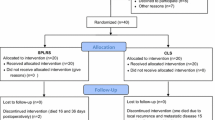Abstract
Ribose-cysteine (RibCys) is a prodrug ofl-cysteine that stimulates glutathione biosynthesis. Increased glutathione levels have been shown to have a protective effect against radiation-induced injury and oxidative stress. Surface oximetry has previously been used successfully to predict anastomotic leakage. PURPOSE: The following study was done to evaluate the protective effect of RibCys and the predictive value of PtO2 determinations in a swine model. METHODS: Domestic swine were divided into three groups: Group A served as a nonradiated control; Group B received 6,000 to 6,500 rad to the rectosigmoid; and Group C received RibCys (1 g/kg) prior to receiving 6,000 to 6,500 rad. Radiated animals and controls underwent rectosigmoid resection after a three-week rest period. Intraoperative anastomotic PtO2 was checked with a modified Clark electrode. Anastomoses were evaluated radiographically at three and seven days; animals were sacrificed, and bursting strength was recorded at 10 days. RESULTS: Mean bursting pressures were 243.8±59.4, 199.5±37.8, and 209.5±54.9 mmHg (NS) for Groups A, B, and C, respectively. Anastomotic PtO2 ranged from 19 to 98 mmHg and could not be correlated with anastomotic leaks or bursting pressure. There were 11/15 radiation-related deaths and leaks (eight deaths and three leaks) in the radiated group and 4/12 radiation-related deaths and leaks (three deaths and one leak) in the group receiving radiation and RibCys (P < 0.04). CONCLUSIONS: 1) RibCys protected animals against radiation-related deaths and anastomotic leaks following high doses of pelvic irradiation; 2) anastomotic PtO2 levels did not correlate with anastomotic healing in this model.
Similar content being viewed by others
References
Blake DP, Bubrick MP, Kochsiek GG,et al. Low anterior anastomotic dehiscence following preoperative irradiation with 6000 rads. Dis Colon Rectum 1984;27:176–81.
Anseline PF, Lavery IC, Fazio VW, Jagelman DG, Weakley FL. Radiation injury of the rectum: evaluation of surgical treatment. Ann Surg 1981;194:716–24.
Galland RB, Spencer J. Surgical aspects of radiation injury to the intestine. Br J Surg 1979;66:135–8.
Russell JC, Welch JP. Operative management of radiation injuries of the intestinal tract. Am J Surg 1979;137:433–42.
Senagore AJ, Milsom JW, Walshow RK, Mostoskey U, Dunstan R, Chaudry IH. ATP magnesium chloride in radiation injury. Surgery 1992;112:933–9.
Washburn LC, Rafter JJ, Hayes RL. Prediction of the effective radioprotective dose of WR-2721 in humans through an interspecies tissue distribution study. Radiat Res 1976;66:100–5.
Weichselbaum R, Hellman S. Chapter 11: Basic principles of radiation biology and radiation oncology. In: Pilch Y, ed. Surgical Oncology. New York: McGraw Hill, 1984:192–3.
Mitchell JR, Bigalow JE, Russo A. Role of glutathione and other endogenous thiols in radiation protection. Pharmacol Ther 1988;39:269–74.
Voss O, Roos-Verhey WS. Radio protection by glutathione esters and cysteamine in normal and glutathione depleted mammalian cells. Int J Radiat Biol 1988;53:273–81.
Sheridan WG, Lowndes RH, Young HL. Tissue oxygen tension as a predictor of colonic anastomotic healing. Dis Colon Rectum 1987;30:867–71.
Ellis F. Fractionation in radiotherapy. Mod Trends Radiother 1967;1:34–51.
Ellis F. The relationship of biologic effect to dose-time fractionation factors in radiotherapy. Curr Top Radiat Res 1968;4:357–97.
Sheridan WG, Lowndes RH, Young HL. Intraoperative tissue oximetry in the human gastrointestinal tract. Am J Surg 1990;159:314–9.
Fletcher GH. Textbook of radiotherapy. Philadelphia: Lea & Febiger, 1973:121–51.
Withers HR. Biologic basis for altered fractionation schemes. Cancer 1985;55:2086–95.
Bubrick MP, Rolfsmeyer ES, Schauer RM,et al. Effects of high-dose and low-dose preoperative irradiation on low anterior anastomosis in dogs. Dis Colon Rectum 1982;25:406–15.
Smith AD, Bubrick MP, Mestitz ST,et al. Evaluation of the biofragmentable anastomotic ring following preoperative irradiation to the rectosigmoid in dogs. Dis Colon Rectum 1988;31:5–9.
Kram HB, Appel PL, Fleming AW, Shoemaker WC. Assessment of intestinal and renal perfusion using surface oximetry. Crit Care Med 1986;14:707–13.
Snyder JR, Pascoe JB, Holland M, Kurpershoek CJ. Surface oximetry of healthy and ischemic equine intestine. Am J Vet Res 1986;47:2530–5.
Shandall A, Lowndes R, Young HL. Colonic anastomotic healing and oxygen tension. Br J Surg 1985;72:606–9.
Roberts JC, Nagasawa HT, Zera RT, Fricke RF, Goon DJ. Prodrugs ofl-cysteine as protective agents against acetaminophen-induced hepatotoxicity: 2-(polyhydroxyalkyl) and 2-(polyacetoxyalkyl) thiazolidine-4 (R)-carboxylic acids. J Med Chem 1987;30:1891–6.
Taniguchi M, Hirayama K, Yamaguchi K, Tateishi N, Suzuki M. Nutritional aspects of glutathione metabolism and function. In: Dolphin D, Poulson R, Avramovic O, eds. Glutathione: chemical, biochemical and medical aspects, part B. New York: John Wiley & Sons, 1989:645–7.
Roberts JC, Charyulu RL, Zera RT, Nagasawa HT. Protection against acetaminophen hepatotoxicity by ribose-cysteine (RibCys). Pharmacol Toxicol 1992;70:281–5.
Roberts JC, Francetic DJ, Zera RT.l-Cysteine pro-drug protects against cyclophosphamide urotoxicity without compromising therapeutic activity. Cancer Chemother Pharmacol 1991;28:166–70.
Author information
Authors and Affiliations
Additional information
Read at the meeting of The American Society of Colon and Rectal Surgeons, San Francisco, California, June 7 to 12, 1992. Sponsored by a grant from the Minneapolis Medical Research Foundation.
About this article
Cite this article
Rowe, J.K., Zera, R.T., Madoff, R.D. et al. Protective effect of RibCys following high-dose irradiation of the rectosigmoid. Dis Colon Rectum 36, 681–688 (1993). https://doi.org/10.1007/BF02238596
Issue Date:
DOI: https://doi.org/10.1007/BF02238596




